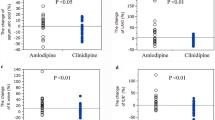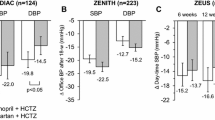Summary
Twenty-three patients with severe hypertension and impaired renal function were included in an open study of the efficacy and tolerance of felodipine treatment over 6 months. All patients were previously treated with a diuretic, a beta blocker, and a vasodilator, and eight of them also received an ACE inhibitor. At the start of felodipine treatment the previously used vasodilator was withdawn. In nine patients the concomitant antihypertensive treatment was reduced during the study. The glomerular filtration rate (GFR), as51Cr EDTA clearance, was determined before and at the end of the study. The blood pressure (BP) and heart rate (HR) were recorded at all clinical visits in the moring 12 hours after the evening dose of felodipine and 2 hours after the morning dose. Plasma concentrations of felodipine were measured at every visit before the morning dose and 2 hours after dose.
The BP was reduced after felodipine was substituted for the previously used vasodilator. A significant additional antihypertensive effect was recorded 2 hours after the dose and amounted to −37±22/−15±12 mmHg (p=0.0001/p=0.0002) at 6 months. The effect measured 12 hours after the dose was less pronounced and was −11±28/−6±10 mmHg (p=0.15/p=0.03). Mean GFR was unchanged during the study, 38±19 versus 38±19 ml/min (n=16).
There was a sixfold interindividual variation in the trough plasma concentrations at steady state at the same drug dosage. Higher plasma concentrations seemed to be required to achieve the same antihypertensive effects as in patients with less severe hypertension and normal renal function. The frequency of adverse effects and the number of patients withdrawn (n=5) were somewhat higher than reported in patients with normal renal function and may be related to the high doses (up to 80 mg daily) used. In conclusion our data suggest that felodipine, in addition to other antihypertensives, is effective and is usually well tolerated in the treatment of patients with severe hypertension and reduced renal function. In order to ensure a more even reduction of BP over the day, a tid dosage regimen of the plain-tablet formulation used in this study may be preferable.
Similar content being viewed by others
References
Folkow B. Physiological aspects of primary hypertension.Physiol Rev 1982;62:347–504.
Ljung B. Vascular selectivity of felodipine.Drugs 1985;29 (Suppl 2):46–58.
Edgar B, Bengtsson E, Elmfeldt D, et al Acute diuretic/natriuretic properties of felodipine in man.Drugs 1985;29 (Suppl 2):176–184.
Hulthén LU, Katzman PL. Renal effects of acute and longterm treatment with felodipine in essential hypertension.J. Hypertens 1988;6:231–237.
Herlitz H, Aurell M, Björck S, et al.. Renal effects of felodipine in hypertensive patients with reduced renal function.Drugs 1985;29 (Suppl 2):192–197.
Herlitz H, Nyberg G, Granerus G, et al. Effects of felodipine in patients with refractory hypertension and progressive renal disease.Scand J Urol Nephrol 1988; (Suppl 108):31–34.
Bröchner-Mortensen J. A simple method for determination of glomerular filtration rate.Scand J Clin Lab Invest 1972;30:271–274.
Bröchner-Mortensen J, Rödbro P. Selection of routine method for determination of glomerular filtration rate in adult patients.Scand J Clin Lab Invest 1976;36:35–43.
Ahnoff M, Ervik M, Johnsson L. Comparison of highselectivity gas chromatographic methods including column switching, for the determination of felodipine in plasma.Chromatography 1987;394:419–427.
Elmfeldt D, Edgar B. Relation between plasma concentration of felodipine and effect on diastolic blood pressure. 2nd Cardiovascular Pharmacotherapy International Symposium, San Francisco, USA 1987;232.
Edgar B, Collste P, Haglund K, et al. Pharmacokinetics and haemodynamic effects of felodipine as monotherapy in hypertensive patients.Clin Invest Med 1987;10:388–394.
Shapiro, et al. The trough-to-peak ratio of felodipine, a novel approach to the evaluation of a tihypertensive efficacy throughout the dosing interval (abstract #1091).Am J Hypertens 1988;1:23A.
Hansson L, Dahlöf B, Gudbrandsson T, et al. Antihypertensive effect of felodipine or hydralazine when added to β-blocker therapy.J Cardiovasc Pharmacol 1988;12:94–101.
Andersson O, Hansson L, Sivertsson R, Primary hypertension refractory to triple drug treatment: A study in central and peripheral hemodynamics.Circulation 1978;58:615–622.
Edgar B, Regårdh CG, Johnsson G, et al. Felodipine kinetics in healthy men.Clin Pharmacol Ther 1985;38:205–211.
Edgar B, Regårdh CG, Attman PO, et al. Pharmacokinetics of felodipine in patients with impaired renal function.Br J Clin Pharmacol 1989;27:67–74.
Romero JC, Raij L, Granger JP, Ruilope LM, Rodicio JL. Multiple effects of calcium entry blockers on renal function in hypertension.Hypertension 1987;10:140–151.
Andersson OK, Granerus G, Hedner T. Felodipine, a calcium-inhibitory vasodilator in refractory hypertension.Drugs 1985;29 (Suppl 2):102–108.
Loutzenhiser RD, Epstein M, Hoston C. Inhibition by diltiazem of pressure-induced afferent vasoconstriction in the isolated perfused rat kidney.Am J Cardiol 1987;59:72A–75A.
Loutzenhiser RD, Epstein M. Renal hemodynamic effects of calcium antagonists.Am J Med 1987;82 (Suppl 3B):23–28.
Navar LG, Champion WJ, Thomas CE. Effects of calcium channel blockade on renal vascular resistance responses to changes in perfusion pressure and angiotensin-converting enzyme inhibition in dogs.Circ Res 1986;58:874–881.
Gustafsson D. Microvascular mechanism involved in calcium antagonist oedema formation.J Cardiovasc Pharmacol 1987;10 (Suppl 1):121–131.
Hedner T, Elmfeldt D, Dahlöf C, et al. Comparison of antihypertensive effect and pharmacokinetics of conventional and extended release felodipine tablets in patients with arterial hypertension.Drugs 1987;34 (Suppl 3):125–131.
Hart W, Westberg B. Felodipine extended release tablets once daily versus plain tablet twice daily in hypertension.J Cardiorasc Pharmacol 1988;12 (Suppl 6):s190.
Author information
Authors and Affiliations
Rights and permissions
About this article
Cite this article
Larsson, R., Lindsjö, M.K., Danielsson, B. et al. Felodipine in the treatment of patients with severe hypertension and impaired renal function. Cardiovasc Drug Ther 4, 253–259 (1990). https://doi.org/10.1007/BF01857641
Issue Date:
DOI: https://doi.org/10.1007/BF01857641




